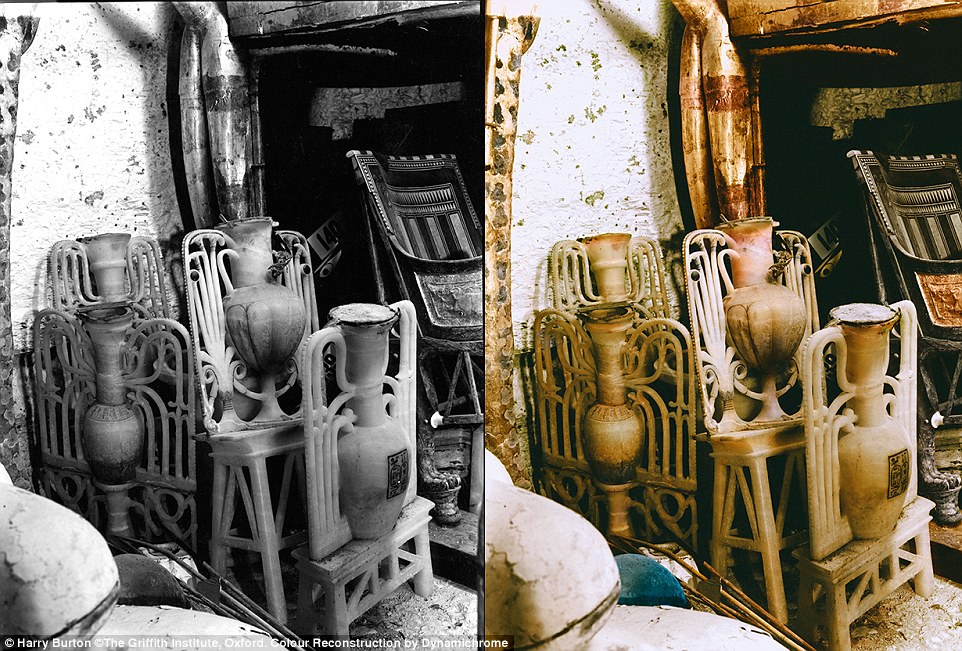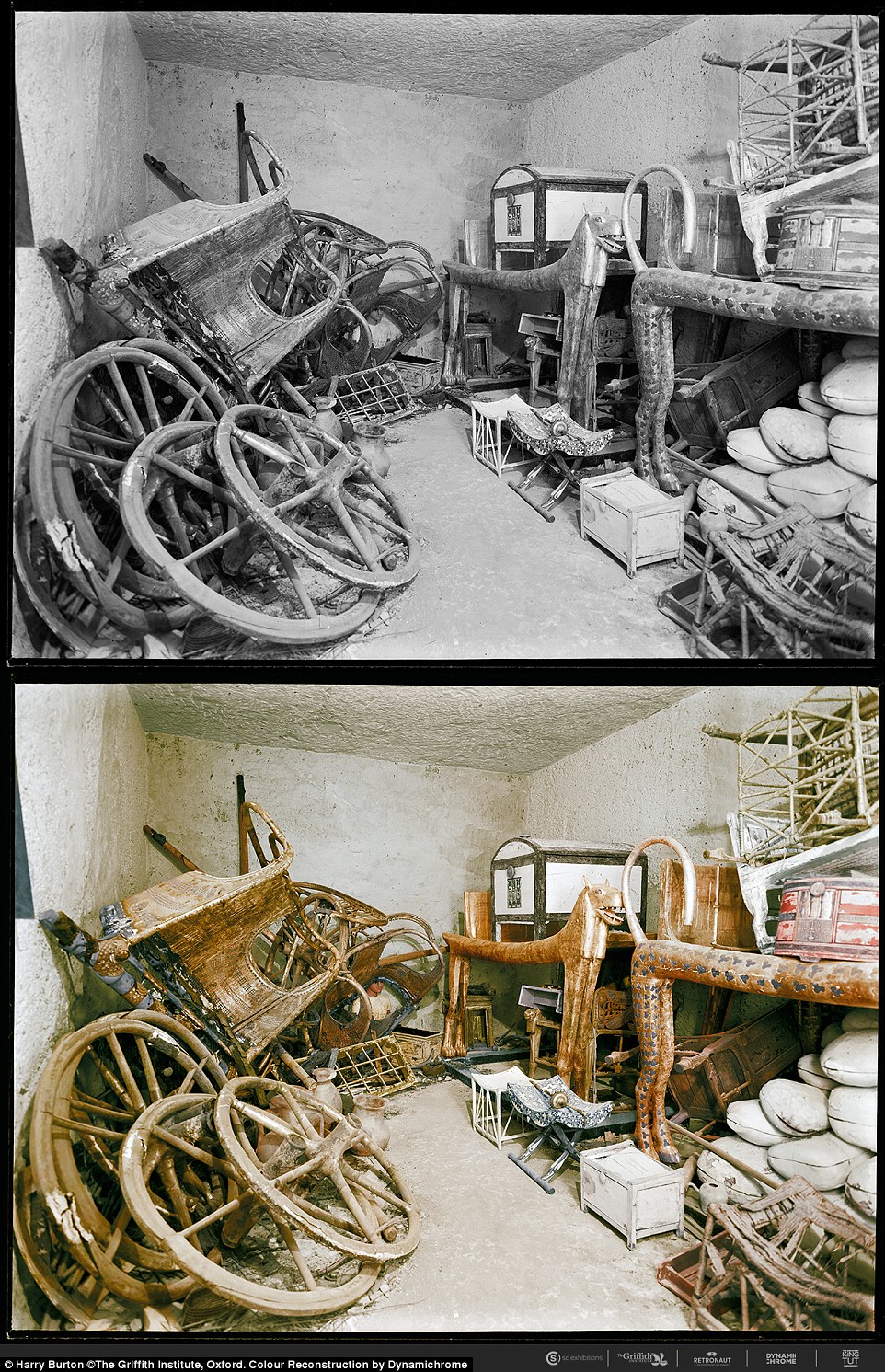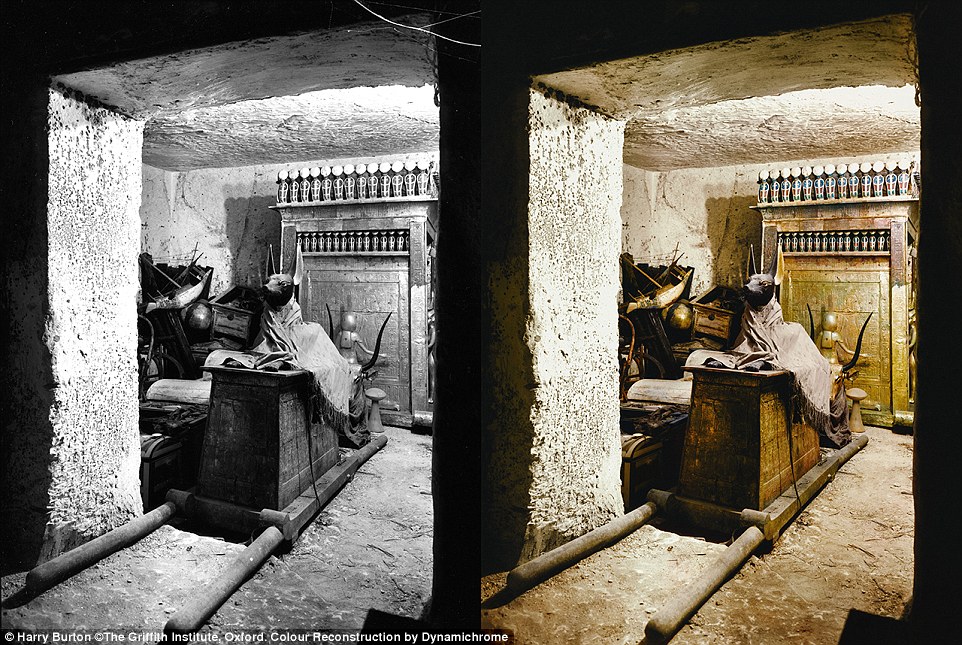After 3,000 years, long-kept mysteries are finally unveiled, providing fresh insight into King Tutankhamun’s unexplained demise.

In 1922, the discovery of Tutankhamun’s 3,000-year-old burial chamber captivated the world.
It was the culmination of a 15-year search which eventually uncovered 5,000 antiques – including the king’s sarcophagus, his gold mask, and stillborn mummies.
This week, on the 93rd anniversary of the find, researchers have unveiled newly colourised photos of the discovery.
The pictures were taken by British photographer Harry Burton during the excavation process and have been made from the original glass plate negatives.

The discovery of Tutankhamun’s 3,000-year-old burial chamber in 1922 captivated the world. This week, on the 93rd anniversary of the find, researchers colourised black and white photos of the discovery. This image was taken in November 1925, and shows Tutankhamun lying intact with his burial mask on. The photograph was taken as the coffin lid was taken off
They tell the story of English archaeologist and Egyptologist Howard Carter, who was asked in 1907 to supervise excavations in the Valley of the Kings.
By that point, Carter had been in in Egypt since 1891 and most of the ancient Egyptian tombs had been discovered.
But very little was known about King Tutankhamen, who had died when he was 19.
On 4 November 1922, Carter’s group found steps that led to Tutankhamun’s tomb near the entrance to the tomb of King Ramses VI in the Valley of the Kings, as reported in Mashable.
Later that month, Carter and fellow archaeologist Lord Carnarvon entered the interior chambers of the tomb, finding them miraculously intact.
From then a famous exchange between Lord Carnarvon and Carter took place.
‘Can you see anything?’ asked George Herbert, the fifth Earl of Carnarvon, standing in a gloomy passageway cut into the bedrock of the Valley of the Kings, on the west bank of the Nile.
The photographs tell the story of English archaeologist and Egyptologist Howard Carter, who was asked in 1907 to supervise excavations in the Valley of the Kings. In this image Carter and a worker examine the solid gold innermost sarcophagus, shown within a gilded, laminated wood coffin of different coloured glass

The antechamber captured in December 1922. Pictured are ornately carved alabaster vases in the antechamber, containing perfume. The pictures, taken by British photographer Harry Burton, have been made from the original glass plate negatives
This December 1922 image shows the antechamber. Scroll left to see the colourised version of the original, Under the lion bed in the antechamber are several boxes and chests, and an ebony and ivory chair which Tutankhamun is believed to have used as a child
KING TUT’S TOMB MAY HAVE HIDDEN BURIAL CHAMBERS, SAYS STUDY
The discoveries to made in King Tut’s burial chamber are far from complete.
A ground-breaking investigation of King Tut’s tomb to find secret chambers will begin today and will last until Friday, Egypt’s Minister of Antiquity said this week.
Researchers believe Tutankhamun’s tomb may contain two hidden chambers.
Egypt’s antiquities minister, Mamdouh Eldamaty, claimsscratching and markings on the northern and western walls are strikingly similar to those found by Howard Carter on the entrance of King Tut’s tomb.
This lends support to a new theory that a queen may be buried in the walls of the 3,300 year-old pharaonic mausoleum.
The theory was put forward last month by British Egyptologist Nicholas Reeves.
He claimed to have found a ‘ghost’ doorway hiding beneath the plaster on the wall of the burial chamber, which he said leads to the tomb of the ruler’s supposed mother, Queen Nefertiti.
‘Yes,’ replied Carter, who was peering at the antechamber to the royal tomb. ‘Wonderful things.’
‘At first I could see nothing, the hot air escaping from the chamber causing the candle flame to flicker,’ Carter later recalled.
‘But presently, as my eyes grew accustomed to the light, details of the room within emerged slowly from the mist, strange animals, statues, and gold—everywhere the glint of gold.’
To document the entire process, the Metropolitan Museum sent Burton as the excavation photographer.
He was ‘Carter’s eye and memory.’ With his enormous camera and cumbersome negative plates, Burton trekked between the discovery site, his laboratory and his improvised darkroom.
‘Every step of the excavation work was documented in photographs, right down to the smallest detail,’ according to Premier Exhibition, who are displaying the photos.
‘The results of Burton’s labours are 2,800 large-format glass negatives, which document all of the finds, their location in the tomb and every single step of the excavators’ work with the utmost precision.
‘Carter patiently and unconditionally encouraged him like no other member of his team and, thanks to his photos, Burton was the first and only archaeological photographer to achieve worldwide fame.’
The colourised black and white photographs, colourised in minute detail by Dynamichrome, are part of a new exhibition opening in New York called The Discovery of King Tut.
Working with the Griffith Institute of Oxford and SC Exhibitions, over 700 hours of work went into the colourisation of the images, to be sure it was accurate down to exact shades and tones.
But the discoveries to make made in King Tut’s burial chamber are far from complete.
A ground-breaking investigation of King Tut’s tomb to find secret chambers will begin today and will last until Friday, Egypt’s Minister of Antiquity said this week.
Researchers believe Tutankhamun’s tomb may contain two hidden chambers.
Egypt’s antiquities minister, Mamdouh Eldamaty, claimss cratching and markings on the northern and western walls are strikingly similar to those found by Howard Carter on the entrance of King Tut’s tomb

The Antechamber Numerous chariots are stacked up against the wall in this image. The discovery was the culmination of a 15-year search which eventually uncovered 5,000 antiques – including the king’s sarcophagus, his gold mask, and stillborn mummies
Pictured is ‘The Treasury. A gilded bust of the Celestial Cow Mehet-Weret and chests sit in the treasury of the tomb. ‘As my eyes grew accustomed to the light, details of the room within emerged slowly from the mist, strange animals, statues, and gold,’ said Carter
This lends support to a new theory that a queen may be buried in the walls of the 3,300 year-old pharaonic mausoleum.
The theory was put forward last month by British Egyptologist Nicholas Reeves.
He claimed to have found a ‘ghost’ doorway hiding beneath the plaster on the wall of the burial chamber, which he said leads to the tomb of the ruler’s supposed mother, Queen Nefertiti.
Famed for her exquisite beauty, the grave of Nefertiti or the ‘Lady of the Two Lands’ has been lost for centuries since her sudden death in 1340 BC.
Previous DNA analysis has suggested King Tutankhamun’s mother may have been a mummy known as the Younger Lady, who is also thought to be his father’s sister.
However, there are some Egyptologists who claim that it is actually Nefertiti, the chief wife of Pharaoh Akhenaten and mother to six of his children, who is Tutankhamun’s mother.
Dr Nicholas Reeves, an English archaeologist at the University of Arizona, has now provided new evidence to support these claims in a report published by the Amarna Royal Tombs Project.
After analysing high-resolution scans of the walls of Tutankhamun’s grave complex in the Valley of the Kings, Dr Reeves spotted what appeared to be a secret entrance.

A statue of Anubis on a shrine with pallbearers’ poles in the treasury of the tomb. Anubis, the canid-headed god was associated with the afterlife – a role of which Anubis would weigh the heart of the deceased to determine if they were worthy of entering the land of the dead
An assortment of model boats in the treasury of the tomb. In all, some 35 boats were located throughout the tomb, symbolic of the transporting the king on his journey through the streams of the underworld towards resurrection

Lord Carnarvon (right), financier of the excavation and Howard Carter posing outside the Burial Chamber. Lord Carnarvon had threatened to pull Carter’s funding just before the discovery of King Tut’s burial chamber was made

Howard Carter (left), Arthur Callender (center) and an Egyptian worker (right) wrap one of the sentinel statues for transport. The colourised black and white photographs are part of a new exhibition opening in New York called The Discovery of King Tut
He described how he uncovered the ‘ghosts’ of two portals that tomb builders blocked up, one of which is believed to be a storage room.
The other, on the north side of Tutankhamun’s tomb, contains ‘the undisturbed burial of the tomb’s original owner – Nefertiti’, Dr Reeves argued.
If Dr Reeves is correct, the hidden tomb could be far more magnificent than anything found in Tutankhamun’s burial chamber.
He believes it is her tomb due to its position positioned to the right of the entrance shaft, which is far more typical of Egyptian queens rather than kings.
The small size of Tutankhamun’s burial chamber, given his standing in the Egyptian history, has baffled experts for years and Dr Reeves’ theory could suggest that it was built as an addition to an existing tomb – his mother’s.
Tutankhamun’s burial chamber is the same size as an antechamber, rather than a tomb fit for an Egyptian King, for example.
Dr Reeve said the richness of the furnishings crammed into Tutankhamun’s four small chambers as ‘overwhelming’.
The majority of Egyptologists have taken this at face value, he said many of the objects there appear to have been taken from predecessor kings and adapted for the boy-king’s use.
He proposes that some of the material in the tomb suggest Nefertiti had been the boy’s co-regent.
Combined with the scans of the north wall of the tomb, Dr Reeves believes the tomb belonged to Nefertiti and the pharaoh’s room was simply an afterthought, describing it as a ‘corridor-style tomb-within-a-tomb’.

In a ‘laboratory’ set up in the tomb of Sethos II, conservators Arthur Mace and Alfred Lucas clean one of the statues from the antechamber
Arthur Mace (left) and Alfred Lucas work on a golden chariot from Tutankhamun’s tomb outside the ‘laboratory’ in the tomb of Sethos II

The Burial Chamber is shown here. Carter, Callender and two Egyptian workers carefully dismantle one of the golden shrines found within
Inside the outermost shrine in the burial chamber, a huge linen pall with gold rosettes, reminiscent of the night sky, covers the smaller shrines within. The mural upon right northern wall depicts three scenes of Tutankhamun in the guise of Osiris, with Ay, the new Pharaoh performing the ‘opening of the mouth ceremony’. On the left western wall are shown various Egyptian deities such as Horus and Maat
The opening of what is believed to have been Nefertiti’s tomb is decorated with religious scenes, perhaps in a ritual to provide protection to the chamber behind it, he said.
‘Only one female royal of the late 18th Dynasty is known to have received such honours, and that is Nefertiti’, Dr Reeves writes.
If Dr Reeves’ theory is correct, it may resolve a number of oddities about Tutankhamun’s burial chamber that have long baffled researchers.
For instance, the treasures found within seem to have been placed there in a rush, and are largely second-hand.
‘The implications are extraordinary,’ he wrote.
‘If digital appearance translates into physical reality, it seems we are now faced not merely with the prospect of a new, Tutankhamun-era store room to the west [but] that of Nefertiti herself, celebrated consort, co-regent, and eventual successor of Pharaoh Akhenaten.’
Joyce Tyldesley, senior lecturer in Egyptology at the University of Manchester, told The Times that Dr Reeves’s hypothesis may prove correct.
‘It would not be surprising if the tomb had been intended to have additional rooms, although how far the builders got with these rooms it is difficult to say on current evidence,’ she said.
‘I would be very surprised if this tomb was built to house the original, or first, burial of Nefertiti.
Howard Carter and an Egyptian worker open the doors of the innermost shrine and get their first look at Tutankhamun’s sarcophagus
A view inside the burial chamber soon after its discovery where the researchers carefully roll up the linen pall covering the second shrine

Howard Carter examines Tutankhamun’s sarcophagus. The discovery of Tutankhamun’s mummy revealed that he was about 17 when he died and probably inherited the throne at the age of eight or nine
‘It seems to me that it is highly likely that she died during her husband’s reign and so would have been buried at Amarna, the city purpose-built by Akhenaten in Middle Egypt.
‘But I would have expected her to be buried somewhere in the Western Valley, rather than in the centre of the Valley of the Kings.’
Nefertiti, whose name means ‘the beautiful one has come,’ was the queen of Egypt and wife of Pharaoh Akhenaten during the 14th century B.C.
She and her husband established the cult of Aten, the sun god, and promoted artwork in Egypt that was strikingly different from its predecessors.
Her titles suggests she was co-regent and possibly a pharaoh after Akhenaten’s death. But despite her remarkable status, her death and burial remains a mystery.
‘Each piece of evidence on its own is not conclusive, but put it all together and it’s hard to avoid my conclusion,’ Mr Reeves told The Economist.
‘If I’m wrong I’m wrong, but if I’m right this is potentially the biggest archaeological discovery ever made.’
The images were unveiled by Factum Arte, a group which recently created a life-sized copy of Tutankhamun’s tomb, intended for tourists to visit.
The discovery of Tutankhamun’s tomb in 1922 caused a worldwide sensation. The rich furnishings and decorations have entranced the public while archaeologists have puzzled over the king’s death.
He was found buried with two stillborn children and his passing ended the Thutmosid family line.
Tutankhamun’s death led to war as he was succeeded by his adviser Ay, who married the boy king’s widow. Under his rule Egypt was defeated in a war with the Hittites.

Arthur Callender (right), assistant to British archaeologist Howard Carter (center) and two Egyptian workers carefully dismantle one of the golden shrines within the burial chamber

Lord Carnarvon reads on the veranda of Carter’s house near the Valley of the Kings. On 19 March 1923 Carnarvon suffered a severe mosquito bite infected by a razor cut and died a month later.